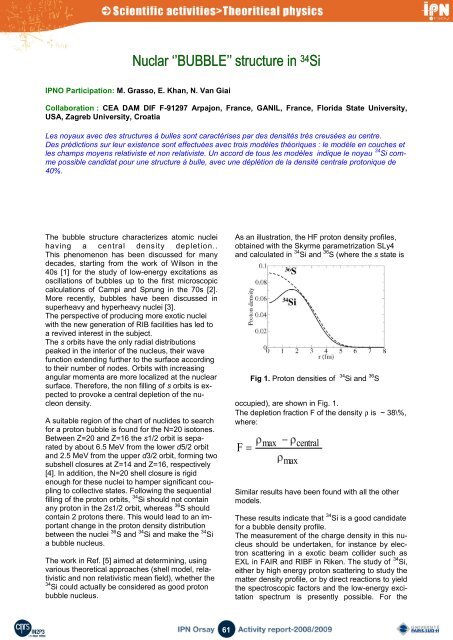exotic nuclei structure and reaction noyaux exotiques ... - IPN - IN2P3
exotic nuclei structure and reaction noyaux exotiques ... - IPN - IN2P3
exotic nuclei structure and reaction noyaux exotiques ... - IPN - IN2P3
You also want an ePaper? Increase the reach of your titles
YUMPU automatically turns print PDFs into web optimized ePapers that Google loves.
Nuclar ‘’BUBBLE’’ <strong>structure</strong> in 34 Si<br />
<strong>IPN</strong>O Participation: M. Grasso, E. Khan, N. Van Giai<br />
Collaboration : CEA DAM DIF F-91297 Arpajon, France, GANIL, France, Florida State University,<br />
USA, Zagreb University, Croatia<br />
Les <strong>noyaux</strong> avec des <strong>structure</strong>s à bulles sont caractérises par des densités très creusées au centre.<br />
Des prédictions sur leur existence sont effectuées avec trois modèles théoriques : le modèle en couches et<br />
les champs moyens relativiste et non relativiste. Un accord de tous les modèles indique le noyau 34 Si comme<br />
possible c<strong>and</strong>idat pour une <strong>structure</strong> à bulle, avec une déplétion de la densité centrale protonique de<br />
40%.<br />
The bubble <strong>structure</strong> characterizes atomic <strong>nuclei</strong><br />
having a central density depletion..<br />
This phenomenon has been discussed for many<br />
decades, starting from the work of Wilson in the<br />
40s [1] for the study of low-energy excitations as<br />
oscillations of bubbles up to the first microscopic<br />
calculations of Campi <strong>and</strong> Sprung in the 70s [2].<br />
More recently, bubbles have been discussed in<br />
superheavy <strong>and</strong> hyperheavy <strong>nuclei</strong> [3].<br />
The perspective of producing more <strong>exotic</strong> <strong>nuclei</strong><br />
with the new generation of RIB facilities has led to<br />
a revived interest in the subject.<br />
The s orbits have the only radial distributions<br />
peaked in the interior of the nucleus, their wave<br />
function extending further to the surface according<br />
to their number of nodes. Orbits with increasing<br />
angular momenta are more localized at the nuclear<br />
surface. Therefore, the non filling of s orbits is expected<br />
to provoke a central depletion of the nucleon<br />
density.<br />
A suitable region of the chart of nuclides to search<br />
for a proton bubble is found for the N=20 isotones.<br />
Between Z=20 <strong>and</strong> Z=16 the s1/2 orbit is separated<br />
by about 6.5 MeV from the lower d5/2 orbit<br />
<strong>and</strong> 2.5 MeV from the upper d3/2 orbit, forming two<br />
subshell closures at Z=14 <strong>and</strong> Z=16, respectively<br />
[4]. In addition, the N=20 shell closure is rigid<br />
enough for these <strong>nuclei</strong> to hamper significant coupling<br />
to collective states. Following the sequential<br />
filling of the proton orbits, 34 Si should not contain<br />
any proton in the 2s1/2 orbit, whereas 36 S should<br />
contain 2 protons there. This would lead to an important<br />
change in the proton density distribution<br />
between the <strong>nuclei</strong> 36 S <strong>and</strong> 34 Si <strong>and</strong> make the 34 Si<br />
a bubble nucleus.<br />
The work in Ref. [5] aimed at determining, using<br />
various theoretical approaches (shell model, relativistic<br />
<strong>and</strong> non relativistic mean field), whether the<br />
34 Si could actually be considered as good proton<br />
bubble nucleus.<br />
As an illustration, the HF proton density profiles,<br />
obtained with the Skyrme parametrization SLy4<br />
<strong>and</strong> calculated in 34 Si <strong>and</strong> 36 S (where the s state is<br />
occupied), are shown in Fig. 1.<br />
The depletion fraction F of the density is ~ 38\%,<br />
where:<br />
F<br />
Fig 1. Proton densities of 34 Si <strong>and</strong> 36 S<br />
max<br />
max<br />
central<br />
Similar results have been found with all the other<br />
models.<br />
These results indicate that 34 Si is a good c<strong>and</strong>idate<br />
for a bubble density profile.<br />
The measurement of the charge density in this nucleus<br />
should be undertaken, for instance by electron<br />
scattering in a <strong>exotic</strong> beam collider such as<br />
EXL in FAIR <strong>and</strong> RIBF in Riken. The study of 34 Si,<br />
either by high energy proton scattering to study the<br />
matter density profile, or by direct <strong>reaction</strong>s to yield<br />
the spectroscopic factors <strong>and</strong> the low-energy excitation<br />
spectrum is presently possible. For the<br />
61

















